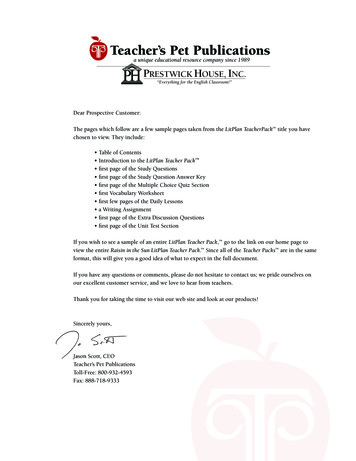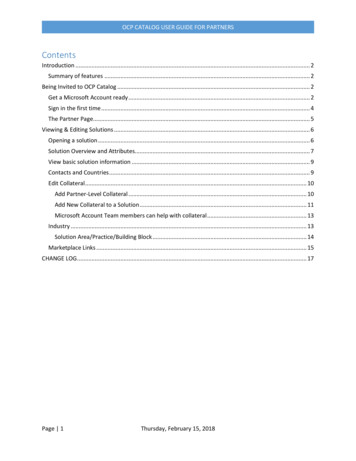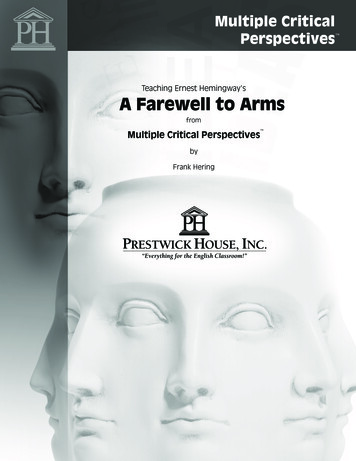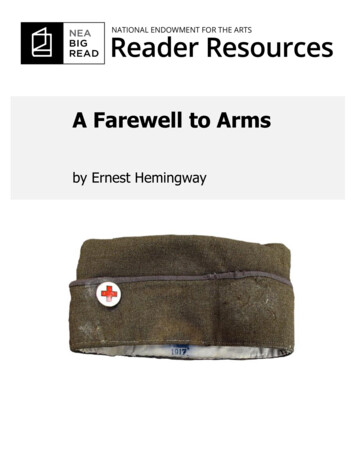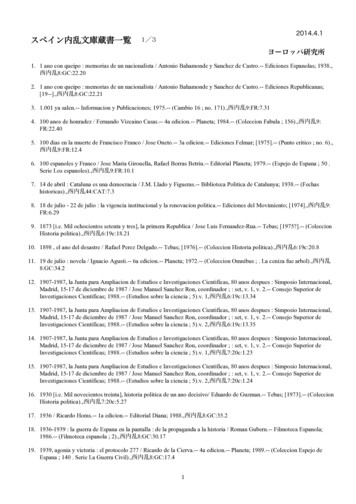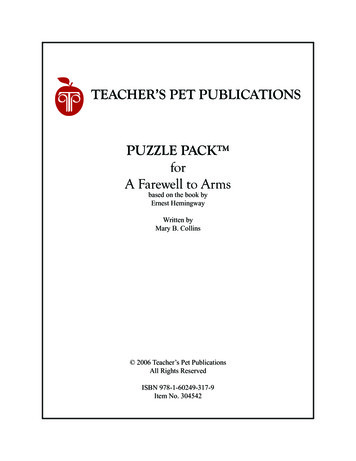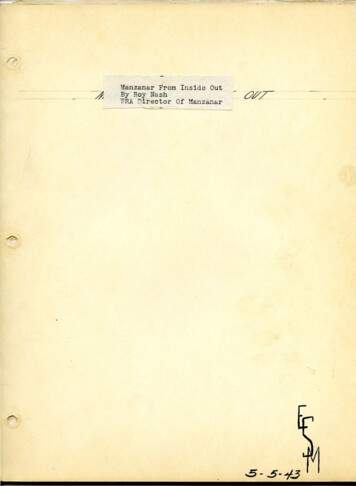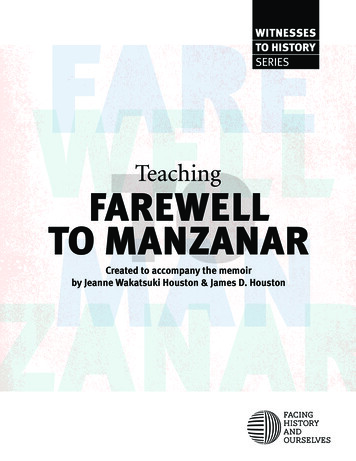
Transcription
TeachingFAREWELLTO MANZANARCreated to accompany the memoirby Jeanne Wakatsuki Houston & James D. Houston
TeachingFAREWELLTO MANZANARCreated to accompany the memoirby Jeanne Wakatsuki Houston & James D. Houston
Facing History and Ourselves is an international educational and professionaldevelopment organization whose mission is to engage students of diverse backgroundsin an examination of racism, prejudice, and antisemitism in order to promote thedevelopment of a more humane and informed citizenry. By studying the historicaldevelopment of the Holocaust and other examples of genocide, students make theessential connection between history and the moral choices they confront in theirown lives. For more information about Facing History and Ourselves, please visit ourwebsite at www.facinghistory.org.Copyright 2018 by Facing History and Ourselves, Inc. All rights reserved.Facing History and Ourselves is a trademark registered in the US Patent & TrademarkOffice.ISBN: 978-1-940457-25-3
CONTENTSUsing This Study Guide1Exploring the Central QuestionSection ElementsHelping Students Process Emotionally Powerful Material123Section 1 Defining Identity and Injustice7OverviewPre-Reading ActivitiesExploring the TextConnecting to the Central QuestionActivities for Deeper UnderstandingExtension ActivitiesHandout: Experiences of InjusticeReading: Overview of Japanese Internment during World War IIReading: The Joe DiMaggio FactorReading: Instructions to All People of Japanese DescentReading: All Americans of Japanese Descent Must ReportReading: Can’t Tell7710121214151619202223Section 2 Questions of Loyalty25OverviewExploring the TextConnecting to the Central QuestionActivities for Deeper UnderstandingExtension ActivitiesReading: Amendments to the ConstitutionReading: Hirabayashi v. United StatesReading: Korematsu v. United StatesReading: Ex Parte Mitsuye EndoHandout: Universe of Obligation: United States, 1942Reading: Concentration CampsReading: Second Opinions252527273132343537383940
Section 3 Free to Go41OverviewExploring the TextConnecting to the Central QuestionActivities for Deeper UnderstandingExtension ActivitiesReading: Japanese Americans in the Armed ForcesHandout: Internment CampsReading: Concentration Constellation4141424344454647Section 4 Re-Entry49OverviewExploring the TextConnecting to the Central QuestionActivities for Deeper UnderstandingExtension ActivitiesHandout: Analyzing QuotationsReading: The “In” Group49495050515253Section 5 Confronting the Past55OverviewExploring the TextConnecting to the Central QuestionActivities for Deeper UnderstandingHandout: Reader ResponseReading: Proclamation 4417: An American PromiseReading: A Letter to Japanese Americans55555657596062Final Writing Assignment63Handout: Final Writing Assignment Planning Sheet65
USING THIS STUDY GUIDENote on edition: This study guide is based on Farewell to Manzanar by JeanneWakatsuki Houston and James D. Houston (Ember, an imprint of Random HouseChildren’s Books, 2012), ISBN: 978-0-307-97607-9.Teaching strategies, videos, and media referenced throughout thisguide can be found at facinghistory.org/manzanar-media.Jeanne Wakatsuki was just seven years old on December 7, 1941, the day Japan attacked Pearl Harbor, the main American naval base in Hawaii. The next day, theUnited States entered World War II by declaring war on Japan. A few months later, theUnited States government authorized the removal of all Japanese Americans1—regardless of age or citizenship status—from the West Coast. They were sent to prison campssurrounded by barbed wire and guarded by armed soldiers. Not one of them hadbeen tried for a crime or even charged with wrongdoing. They were imprisoned solelybecause of their ancestry.According to the authors, Farewell to Manzanar is a “web of stories tracing a few paths,out of the multitude of paths that led up to and away from the experience of the internment.” That web of stories links Jeanne’s search for her own unique identity to thewrongs done to Japanese Americans during the war.This resource is designed to guide teachers and students through an experience ofFarewell to Manzanar that engages the mind, heart, and conscience. This approachwill develop students’ literacy skills and promote their historical understanding of aperiod of prejudice and persecution toward a minority group in the United States.Most importantly, the goal of this guide is to help students understand the impact ofgrave injustices, especially those that violate our highest national ideals, and considerwhether it is possible to reconcile past injustices with our identities and ideals today,both individually and collectively.Exploring the Central QuestionQ: How do our confrontations with justice and injustice help to shape our identity?How do those confrontations influence the things we say and do?The central question focuses on Jeanne Wakatsuki’s confrontation with injustice—theimprisonment of Japanese Americans during World War II. In describing a return visitto Manzanar, the place where she and her family were held prisoner years earlier, shewrites:I had nearly outgrown the shame and the guilt and the sense of unworthiness.This visit, this pilgrimage, made comprehensible, finally, the traces that remained1The term Japanese Americans is used to refer to both Japanese nationals living in the United States and US citizens ofJapanese descent.Using This Study Guide1
and would always remain, like a needle. That hollow ache I carried during theearly months of internment had shrunk, over the years, to a tiny sliver of suspicion about the very person I was. It had grown so small that I’d sometimes forgetit was there. Months might pass before something would remind me.2Farewell to Manzanar helps us understand “the traces that remained” and why she likens them to a “needle.” In doing so, it raises questions about the effects of an injusticethat has not been acknowledged or judged.This study guide explores the central question by focusing on several connected ideas:justice, injustice, identity, loyalty. As a pre-reading activity, students are asked to reflecton injustices they have witnessed or experienced. Then, as they read, they begin toexplore the impact injustice had on Jeanne Wakatsuki and her family. At the end of thebook, students consider why the author feels that traces of those years remain with heras “a tiny sliver of suspicion about the very person I was.”Section ElementsThis resource is organized into five sections designed to support the careful reading ofspecific pages of the memoir. Each section is broken into three main components (andan optional fourth): Exploring the Text: primarily text-based questions designed to deepen students’understanding of the memoir and to prompt reflection on its themes. You canuse these—and your own—questions as journal or discussion prompts to guidestudents’ exploration of the text. The questions in this section are grouped tofocus on particular themes or subthemes. As students respond to the questions,encourage them to refer to passages or examples from the book to support theirideas. Connecting to the Central Question: a repeating prompt to help studentsconnect what they have learned from the activities in each section to the largertheme of injustice and its influence on our identities and choices. By returning tothe central question in each section of the memoir, students will be able to tracehow their thinking has developed and deepened over the course of their study ofFarewell to Manzanar. Activities for Deeper Understanding: suggestions for writing, reflection, anddiscussion-based activities that support literary analysis, provide historical context, and introduce additional perspectives on the events that take place in thememoir. When appropriate, these activities also invite students to make thematicconnections between Farewell to Manzanar and other texts and universal humanbehaviors. Choose from these activities to find those that best suit your goals andthe needs of your students. Extension Activities: suggestions for writing, reflection, and research that, whilenot essential to a study of the memoir, help students develop a deeper and broader understanding of the history of Japanese internment camps and the experiences of those confined in them.2 Jeanne Wakatsuki Houston and James D. Houston, Farewell to Manzanar (New York: Ember, 2012), 195–96.2Teaching FAREWELL TO MANZANAR
Section 1 also includes a series of pre-reading activities designed to introduce keythemes and concepts before students begin to read the memoir.While it is crucial that students have the opportunity to respond to Farewell toManzanar both intellectually and emotionally, the extent to which teachers engagetheir students in the activities in this guide that extend beyond the pages of the memoir itself will vary depending on available class time and the support students need inunderstanding the text.Helping Students Process EmotionallyPowerful MaterialThe deeply personal and emotional experiences that Jeanne Wakatsuki Houston narrates in Farewell to Manzanar can help to foster engagement and empathy in students,yet they can also be disturbing. While some students may be troubled by this storybecause members of their families and communities suffered as a result of the internment of Japanese Americans, others may struggle to come to grips with this storybecause it recounts actions their communities or country took that they cannot justifymorally or ethically.Before you begin to teach the book, it’s important to acknowledge that students mayhave a range of emotional reactions to this challenging text. Some students may respond with sadness, anger, or disgust, while others may not find the story powerful tothe same degree. In addition, different people demonstrate emotion in different ways.Some students may immediately express outrage, while others will be silent and notwant to talk. Some may appear to be disinterested, and some may take days to processdifficult stories.Establish a Safe SpaceBecause of the range of reactions Farewell to Manzanar may evoke, it is importantto begin the unit by preparing students to engage honestly, but civilly and respectfully, with such a challenging history that includes powerful incidents of racism andpersecution.One effective way to do so is to create a classroom contract. Ask students: What dowe, as a community of learners, need from each other to have a safe yet courageousconversation about history, race, and discrimination in this unit? You can use ourContracting guidelines for creating a classroom contract or another procedure youhave used in the past. Make sure that the contract makes it clear that offensive, dehumanizing, and violent language is unacceptable.Addressing Dehumanizing and Antiquated LanguageFarewell to Manzanar includes terms used in the past to refer to people of Japanese,Chinese, or general Asian descent that today are considered offensive and antiquated. Words such as “Oriental,” “Jap,” and “Chinaman” may be unfamiliar to studentswhen they encounter them in the memoir. Historically, these terms were associatedwith negative stereotypes that obscured the individuality, dignity, and humanity ofJapanese, Chinese, and other Asian Americans. They have also been used as slurs.Therefore, it is crucial for teachers to preview the appearance of these words in theUsing This Study Guide3
book and help students understand their dehumanizing and inappropriate nature. Webelieve that the best way to prepare to encounter this language is to create a classroomcontract outlining guidelines for respectful, reflective classroom discussion.Providing Space to ProcessWe urge teachers to create space for students to have a range of reactions and emotionsas they read and to establish practices in the classroom to reflect on this emotionallypowerful material. Below are three strategies that you can use repeatedly during yourteaching of the memoir.1. Journals: Journals provide a safe, accessible space for students to share thoughts,feelings, and uncertainties as they work with difficult material. They foster apractice of reflection and document students’ evolving thinking. Journal writingcan be used as homework to prepare for class discussion; it can also bring valuable moments of silence into the classroom. Any kind of notebook can be usedfor a journal; what is important is that a student’s journal entries are collectedtogether.There are many different ways to focus students’ writing in journals. A few approaches that work include: Sentence stems: “This section of the memoir makes me feel . . . ”; “AsI read this section of the memoir, I wondered . . . ”; “If I could talk withone of the characters in the memoir, I would want to say/I would want toask . . . ” Lifted line responses: Students select a particular quotation that strikesthem and then answer such questions as, “What is interesting to youabout this quotation? What does it make you think about? What questions does it raise for you?” Freewriting: Students use a defined amount of time to write in silenceabout any aspect of their reading that is on their mind.2. Exit Cards: Exit cards ask students to briefly respond to a question on a smallpiece of paper, like an index card, and hand it in before leaving class for theday. These cards offer immediate feedback for teachers about what studentsare thinking and feeling in response to a lesson or activity. One simple promptfor an exit card is, “What questions, ideas, and feelings did today’s class raisefor you?”3. Color, Symbol, Image: This strategy is adapted from a thinking routine developed by educators at Harvard University’s Project Zero. It invites students toreflect on ideas in nonverbal ways and encourages them to think metaphorically.Students first focus on something they’ve just read and think about the mostimportant theme, idea, or emotion that surfaced for them. Then they reflect onhow they can communicate the essence of what they’ve read using a color,a symbol, and an image.4Teaching FAREWELL TO MANZANAR
In this strategy, start by prompting students this way:Think about the big themes, ideas, or emotions in what you’ve just read, andselect one big idea you’d like to focus on. Then do the following: Choose a color that you think best represents that big idea. Choose a symbol that you think best represents that idea. Choose an image that you think best represents that idea.Students’ responses can be private, or you can apply the Gallery Walk teachingstrategy and ask students to reflect on the patterns, similarities, and differencesin how they are responding to particular sections of Farewell to Manzanar.Using This Study Guide5
6Teaching FAREWELL TO MANZANAR
1DEFINING IDENTITYAND INJUSTICEReading AssignmentForeword – Chapter 5 (pages ix–46)OverviewFarewell to Manzanar opens on December 7, 1941, with the Japanese attack on PearlHarbor. The next day, war is declared. Jeanne, the narrator of the book, describes howthose events affect her family. Within two weeks, FBI agents have sent her father to aprison camp at Fort Lincoln, North Dakota. After his arrest, her mother moves thefamily from Ocean Park, near Santa Monica, California, to nearby Terminal Island tobe closer to Woody, Jeanne’s married brother. In February, the United States Navy orders all people of Japanese descent off the island. So the family moves once again, thistime to a Japanese neighborhood in downtown Los Angeles. There, the family learnsthat in mid-February, President Franklin D. Roosevelt had signed Executive Order9066, which set in motion the forced relocation of all Japanese Americans on the WestCoast to “internment camps.”Within weeks, the Wakatsukis are ordered out of their home and told to report to apickup point in Los Angeles. There, the family is placed aboard a special bus that takesthem to Manzanar, a prison camp in the California desert. At Manzanar, the familystruggles to endure the lack of privacy and other indignities that mark life behindbarbed wire.Pre-Reading Activities1. Define IdentityExplain to students that they will be reading about a young girl who was the victimof a grave injustice. At the age of seven, Jeanne Wakatsuki was sent to a prison campin the California desert along with the rest of her family. Their crime? They were ofJapanese descent at a time when the United States was at war with Japan.Tell students that as they read the memoir, they will be carefully tracing changes in theway others defined Jeanne and how she defined herself. In other words, they will beexamining how Jeanne’s experiences in the Manzanar internment camp influencedher identity.Section 1: Defining Identity and Injustice7
Begin a discussion about the concept of identity. Tell students that our identity, in part,is our answer to the question “Who am I?” Then follow these steps to help studentscreate identity charts for themselves: Tell students to draw a box in the middle of a blank piece of paper and writetheir name inside. Then ask them to add words and phrases around the box that describe themselves. To help them get started, you might suggest the following categories thatpeople often use to describe themselves: gender, age, and physical characteristics,as well as ties to a particular religion, class, neighborhood, school, or nation. Broaden the discussion to consider how the opinions of others might affect ouridentities. Ask students to add to their charts words or phrases that others mightuse to describe them. Finally, ask students what kinds of experiences might have a lasting effect on theway we define ourselves. Have them add to their charts short descriptions of oneor two experiences in their lives that they think have influenced the way theythink about who they are.2. Introduce the Central QuestionTell students that as they read Farewell to Manzanar, they will return several times tothe following central question:Q: How do our confrontations with justice and injustice help to shape our identity?How do those confrontations influence the things we say and do?Give students a few minutes to write down some initial thoughts in response to thesequestions, based on their preliminary exploration of the concept of identity and theprocess of creating their own identity charts. These initial thoughts might include8Teaching FAREWELL TO MANZANAR
attempts to answer the questions, or they might involve highlighting words or phrasesin the questions that they do not yet understand. Either way, let students know that asthey read the memoir, they will have the opportunity to refine their understanding ofthe questions and add to their thinking.3. Understand InjusticeHold a class discussion about injustice.First, ask students what the word justice means to them. Encourage them to give anexample of a just act. Then have the class define the word injustice. What does an injustice look like? Can you feel it? Can you touch it? How does it feel when you witnessan injustice? How does it feel when you experience one? What do all injustices have incommon? How is every act or experience of injustice unique? How does confrontingan injustice affect the way we see ourselves?Next, share with students a time when you or someone you know experienced, witnessed, heard, or read about an act of injustice. Explain how you felt about what happened. If possible, discuss how the other people involved seemed to feel. Describe whatthe incident has meant to you as a person. To what extent has it affected the way yousee yourself? To what extent has it shaped the way you view the world?Then distribute copies of the Experiences of Injustice handout and ask students to answer the questions on the handout or in their journals. Encourage them to share theiranswers, first with a partner and then with the entire class. As students relate theirexperiences, discuss how each is linked to the central question. How do our experiences with injustice influence the way we see ourselves and others?4. Provide Context for Farewell to ManzanarTo provide students with historical context for the book, distribute the reading Overviewof Japanese Internment during World War II. Consider supplementing the readingby showing the documentary And Then They Came for Us (see facinghistory.org/manzanar-media). Then ask students to reflect on and discuss the following questions: How did many Americans view people of Japanese descent before the war? Whatattitudes and values shaped their views? How did Japan’s attack on Pearl Harbor heighten long-held stereotypes andprejudices? After exploring the historical context for Farewell to Manzanar, what is something about this history you found surprising, something you found interesting,and something you found troubling?5. Preview the BookExplain that Farewell to Manzanar is a true story about a young American girl who wasimprisoned during World War II solely because she was of Japanese descent. At the ageof seven, Jeanne Wakatsuki was shipped to a prison camp, also referred to as an internment camp, with her family even though she, like most other Japanese Americans, wasnever charged with treason, sabotage, or any other crime against the nation. The bookexplores the way this grave injustice helped to shape the development of Jeanne’s iden-Section 1: Defining Identity and Injustice9
tity. It also focuses on the meanings we attach to the word loyalty. Injustice, identity,loyalty: these three ideas are central to understanding the book and applying its lessonsto our own lives.Encourage students to preview the book by studying the introductory material providedon pages ix–xv. Focus on the two quotations on the page prior to the start of Part I. Askvolunteers to read these aloud to the class, and then ask students to use them to predictin their journals what the story will be about. Once students have recorded their predictions, assign the first five chapters.Exploring the TextAsk students for their questions or comments about what they have read in thememoir’s first five chapters. Then use the following questions as journal or discussionprompts to guide students’ exploration of the text. These questions, here and throughout the guide, have been grouped to focus the discussion on particular themes orsubthemes. As students respond to the questions, encourage them to refer to passagesor examples from the book to support their ideas.Explore the choices that the family made before and after Pearl Harbor.1. Before the war, what assumptions did Jeanne’s family have about what it meansto be a US citizen?2. Until the war began, Jeanne’s family lived in a predominantly white neighborhood. What values and beliefs shaped her father’s decision to settle in thatneighborhood?3. Why did Papa burn the Japanese flag after the bombing of Pearl Harbor? Whatdoes the incident reveal about his fears? How realistic were those fears?4. Why did Mama move the family to Terminal Island after her husband’s arrest?What values and beliefs shaped her decision?5. Explain why Jeanne’s mother broke the family china before leaving TerminalIsland. What does the incident reveal about her as a person? About the way herlife seemed to be spinning out of control?Consider the factors that lead to stereotypes and prejudices.6. Why does Jeanne blame her father for her fear of “Oriental faces”? Where elsemight she have learned to fear people who look like her? (For example, how didyou and your friends learn whom to trust and whom to fear? What part has yourfamily played in shaping your attitudes and beliefs? What part have your teachersand classmates played? What role do you think books, magazines, newspapers,movies, and TV have played in the way you view other individuals and groups?)7. How does Jeanne’s fear of “Oriental faces” affect the way she views her classmateson Terminal Island? What myths and misinformation might lead her to labelthem as “tough and mean, like ghetto kids everywhere”?8. How does Jeanne overcome her “fear of slanted eyes and high cheekbones”?10Teaching FAREWELL TO MANZANAR
Explore how myths and misinformation can divide a society in timesof crisis.9. What prompts the military to order the evacuation of all Japanese Americansfrom Terminal Island and then, later, from the West Coast?10. Why did many Americans believe that all Japanese Americans were potentialspies? What myths and misinformation may have shaped those beliefs?11. What information and arguments might people have used to challenge mythsand misinformation about Japanese Americans?12. Of the approximately 120,000 Japanese Americans imprisoned during World WarII, about 40,000 were citizens of Japan. The United States was also at war withGermany and Italy. About one million German and Italian citizens lived in theUnited States. Only a handful were ever taken into custody, and no United Statescitizen of Italian or German descent was ever sent to an “internment camp.” Whydo you think people of Japanese descent were considered more dangerous thanpeople of Italian or German descent?13. Later in the memoir (in Chapter 20), Jeanne writes that you cannot forciblyremove 120,000 people from their homes unless you have stopped seeing themas individuals. What evidence in these chapters supports that conclusion? Whatevidence calls that idea into question?14. What kinds of rumors and other stories do people find easiest to believe? Whatstories do they find hardest to accept as true? What are the main differences between the stories you believe without question and those you doubt?Discuss how the family responds to the crisis.15. What action do Jeanne’s mother and her older brothers and sisters take after thearrest of her father? What values and beliefs are reflected in their actions?16. What aspects of internment seem to strengthen family life? What aspects seem toweaken it?17. How does Jeanne explain the way she and her sisters and brothers react to theirfather’s return? How do you explain their reactions?18. Why do you think that Chapter 5 has been titled “Almost a Family”? What doesthe title suggest about the way they define the word family? Do you agree withtheir definition? Why or why not?Explore the way the authors tell the story.19. For the most part, the authors tell Jeanne’s story in the order in which thingshappen. From time to time, however, they interrupt the chronology for a flashback. Find at least three examples of flashbacks in this section of the book.20. Which of the flashbacks provide an insight into a character or a situation? Whichask the reader to compare and contrast specific characters, settings, points ofSection 1: Defining Identity and Injustice11
view, or events? Why else might an author interrupt a story to tell the readerabout an earlier event?21. To what extent do the flashbacks deepen our understanding of the central question of the book?Connecting to the Central QuestionAfter exploring the text and reviewing the events that take place in this section of thebook, provide students with an opportunity to revisit their thinking about this guide’scentral question:Q: How do our confrontations with justice and injustice help to shape our identity?How do those confrontations influence the things we say and do?Give students a few minutes to write down their thoughts about these questions inlight of what they learned about Jeanne’s life before the war and how it changed afterthe attack on Pearl Harbor. What injustices have she and her family faced thus far inthe book? How have these affected the way they think about their own identities? Howhave these dramatic circumstances influenced the choices they make?Activities for Deeper Understanding1. Analyze a DocumentMake copies of the reading Instructions to All People of Japanese Descent, which contains the text of the notice posted on California telephone poles in the spring of 1942.Then divide the class into pairs and give each a copy. Have students read the documentwith their partner and answer the following questions: At whom is the notice aimed? What actions are those individuals required to take? What will happen to those individuals after they follow the instructions outlinedin the poster?Sometimes what is not stated in an official document can be as important as what isstated. Ask partners to identify what important information is left out of this document. (For example, does the document say why the Japanese are being “evacuated”?Does it explain where they will be taken? What will happen to those who fail to follow the “instructions”?) Why do you think General DeWitt left out such importantinformation?Next, have partners reread the document to find examples of euphemisms. A euphemism is an indirect or vague word or phrase used in place of a harsher, blunter, ormore offensive term. People use euphemisms to distance themselves from an event,deny it, camouflage it, or trivialize it. Ask partners to provide the real meaning of eachof the terms they identify. The questions below highlight some of the euphemismsfound in the document.12Teaching FAREWELL TO MANZANAR
What is a non-alien? What does the word evacuate mean? What is an evacuee? What are the “new” or “temporary residences” to which General DeWitt refersthroughout the document? What is a “Civil Control Station”? What is an “Assembly Center”? What does the word instructions usually mean? Are the items listed in thedocument instructions, or are they orders?After students have compiled their lists of euphemisms, ask them to rewrite the“instructions,” substituting more concrete terms for each euphemism. Have partnersshare their edited version with the class. Discuss the way the tone of the documenthas changed.2. The Joe DiMaggio FactorTo further explore how the US government handled other “enemy aliens,” distributecopies of the reading The Joe DiMaggio Factor and use the connection questions forclass discussion or as journ
Some students may immediately express outrage, while others will be silent and not want to talk. Some may appear to be disinterested, and some may take days to process . Addressing Dehumanizing and Antiquated Language Farewell to Manzanar includes terms used in the past to refer to people of Japanese,


